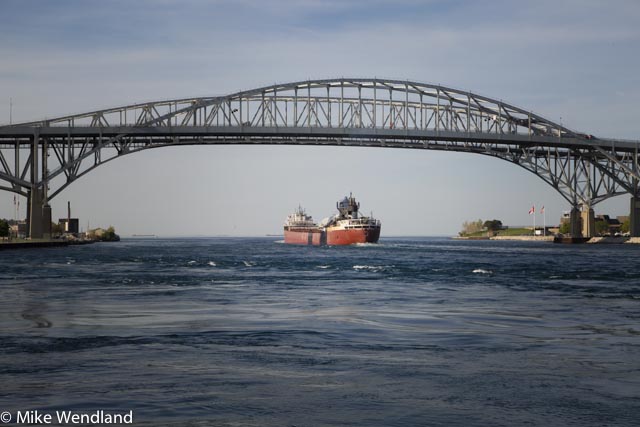Heading to Canada? Spend Time in Port Huron, Mich.
 RVers heading to Canada via Port Huron, MI and the Blue Water Bridge may want to budget a few hours so pull off the freeway and take in the sights of this very busy port city.
RVers heading to Canada via Port Huron, MI and the Blue Water Bridge may want to budget a few hours so pull off the freeway and take in the sights of this very busy port city.
On a nice sunny day, the drive and park along the busy St. Clair River offers parking nose first, right smack dab on the riverbank. A Type B RV fits perfectly and the view of the fast-moving river is mesmerizing.
The river is one of the busiest water routes in the Great Lakes, connecting Lake Huron just north of the Blue Water Bridge to Lake St. Clair, a couple dozen miles downstream. Port Huron’s Riverfront is a mecca for big boat watchers. From Lake St. Clair, the big freighters and ocean going vessels make their way into the Detroit River, which in turn connects to Lake Erie. Ship traffic is constant and you will not have to wait long to see one, upbound or downbound.
But it is also a great fishing river. The fish of choice is walleye and the river serves as a travel corridor for walleye moving between Lake Erie and their spawning grounds in Saginaw Bay, 100 miles up Lake Huron. Fish biologists believe that walleye treat the whole Lake Huron/Erie waters as one system. Walleye can cruise from one body of water to another in days. The St. Clair river is deep and cold which also helps in holding walleye. When outside temps are in the 90′s the St. Clair river will be in the 60′s.
So if there’s a lull in the freighter traffic, watch the local fishermen.
In all, Port Huron has 17 waterfront areas containing 102 acres and 3 1/2 miles of water frontage. This includes two public beaches and six parks with picnic facilities. Our favorite is right beneath and just south of the Bluewater Bridge. The city has nine scenic turnout sites containing over 250 parking spaces. They are well-used throughout the year and often illed to capacity most afternoons and evenings during the warmer months, so you may have to do a bit of cruising until one opens up.
If you can’t get in, make your way north following the signs to Lighthouse Park, right at the mouth of the river. AGain, the parking is fine for a Tye B RV but anything bigger will be hard put to find an adequate space. This park has 900 feet of waterfront and beach and the water is clean for good swimming. But be warned, if you venture out very far, the current is swift as the river starts flowing right from there.
While at Lighthouse Park, walk a few hundred yards south and tour the historic Fort Gratiot Lighthouse. In 1814, military Fort Gratiot was established to guard the juncture of Lake Huron and the St. Clair River. With a surge of vessel traffic on Lake Huron in the early 1800s, the need for a Light Station to guide vessels into the river became very important. Originally seventy-five feet high, the white painted brick tower was extended to its present height of eighty-two feet in the early 1860s. It’s maintained today by the U.S. Coast Guard and open to climbing (for $7 a person). If you do, no sandals are allowed. So put on some closed toes shoes.
For food, Freighter’s Restaurant is a great place with great river views. It’s part of the Doubletree Inn hotel complex and is right in the heart of the riverfront action, a few hundred yards south of the bridge.
One more attraction: The Thomas Edison Depot Museum is right down there, too, pretty much smack dab under the bridge. The famed inventor lived in Pot Huron and worked on a railroad car for his first job form 1859-1863. The museum includes a restored baggage car resting on a short spur of railroad track and has some exhibits about Edison and his early beginnings.
You can easily spend three our hour hours in Port Huron, stretching your legs, freighter watching, even taking a quick dip in the water up by the lighthouse.
Heading to the bridge and then over to Canada is a breeze. The route is well marked.
It costs $3 U.S. to cross. Make sure if they try to charge you more you explain to them that you are in an RV. Commercial vans cost $6 one way.
You do need a passport to cross into Canada.
On the way back to the U.S., the bridge fee is $3.50.
Jennifer watches one of the big lake freighters headed out into Lake Huron.
A Type B RV can easily park right on the riverbank.
The walk along the St. Clair River beneath the Blue Water Bridge is a great place to stretch your legs before heading into Canada.






0 Comments
Recommended Comments
There are no comments to display.
Please sign in to comment
You will be able to leave a comment after signing in
Sign In Now